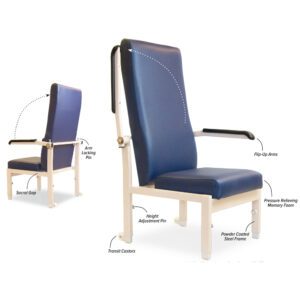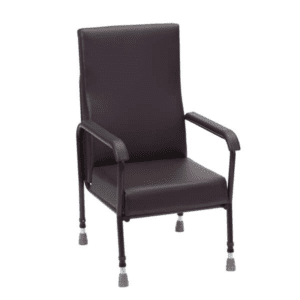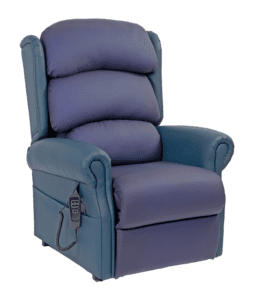What you need to know:
Chair Types: Upright armchairs for stability and posture, high-seat chairs for easier standing, rise & recline chairs for powered assistance, bariatric chairs for heavier users.
Seat Height: Measure from floor to back of knee – typically 18-20 inches (46-51cm) for most older adults.
Best Investment: Rise & recline chairs worth £1,300-2,500 for chronic mobility issues.
Try First: Consider hiring before buying to ensure the perfect fit.
Quick Decision: Choose upright armchairs for the elderly for general support needs. Choose high-seat chairs after surgery or for arthritis. Choose rise & recline for significant mobility challenges.

Standard household chairs are often unsuitable for older people, creating unnecessary challenges and safety risks. Many chairs are too low, making standing difficult and increasing fall risk. Others are too soft, offering insufficient support for good posture or safe transfers. Some lack proper armrests, removing crucial stability during sitting and standing.
This comprehensive guide explains the main seating options available – from supportive upright armchairs for the elderly to sophisticated rise & recline chairs – helping you choose confidently based on specific needs, health conditions, and lifestyle requirements.
Why the Right Chair Matters for Older People
The importance of appropriate seating extends far beyond comfort. The right chair becomes a foundation for maintaining independence, ensuring safety, and supporting overall health and wellbeing in later years.
Comfort and Independence Proper seating allows older people to sit comfortably for extended periods without developing pressure points or discomfort. This enables continued participation in activities like reading, watching television, socialising, and hobbies that contribute to quality of life.
Safety and Fall Prevention Age UK research shows that 4.3 million older people (36%) list falling as their top concern. The right elderly people chair significantly reduces fall risk by providing stable support during transfers and appropriate height for easier standing.
Better Posture and Health Appropriate chairs support good posture, reducing back pain and preventing the development of postural problems. Proper positioning also aids breathing, digestion, and circulation – all crucial for maintaining health as we age.

Upright Armchairs for the Elderly: A Supportive Everyday Option
Upright armchairs for the elderly represent the traditional solution for older people who need reliable, supportive everyday seating. These classic chairs provide firm, supportive seating and armrests, making sitting and rising safer and easier.
| Feature | Benefit | Best For |
| Firm seating | Provides stability and support | Those who need to maintain posture |
| Solid armrests | Assists with standing and sitting | People with mild mobility concerns |
| Upright position | Encourages good posture | General daily use |
| Simple design | Easy to use, matches home décor | Those preferring traditional furniture |
When Upright Armchairs Are Suitable These chairs work well for older people who can stand independently but benefit from additional support. They’re especially suited for those who need to remain upright and maintain good posture during long periods of sitting, such as when reading, watching television, or socialising.
Upright armchairs for the elderly are ideal when mobility concerns are mild, the person values traditional furniture aesthetics, simplicity is preferred over mechanical features, and budget considerations favour more affordable options.
Limitations to Consider While excellent for many situations, upright armchairs offer limited adjustability and may lack the plush cushioning some users prefer for extended comfort periods. They don’t provide mechanical assistance for standing, which may become necessary as mobility decreases.
Chairs for an Older Person: High-Seat Armchairs
High-seat chairs for older persons bridge the gap between standard furniture and powered seating solutions. With elevated seat height and extended back support, these chairs reduce knee and hip strain, making them particularly valuable after surgery or for those with arthritis.
Benefits of High-Seat Design
The elevated seating position significantly reduces the physical effort required to stand up. This is because the higher starting position means less distance to travel and reduced angle change at hip and knee joints during the standing process.
Specific Advantages:
- Reduces strain on joints during transfers
- Promotes better posture through proper positioning
- Easier for carers to assist when needed
- Maintains independence longer than standard height chairs
- Suitable for people of varying heights with proper measurement
Related: Recovery solutions after hip and knee surgery
When High-Seat Chairs Are Most Suitable
Post-Surgery Recovery After hip or knee replacement surgery, high-seat chairs are often recommended by occupational therapists. The elevated position protects healing joints by reducing the range of motion required during transfers.
Arthritis Management For those with arthritis affecting knees, hips, or back, the reduced bending required with high-seat chairs can significantly decrease pain and stiffness during daily activities.
Progressive Mobility Changes High-seat chairs work well for people experiencing gradual mobility changes who aren’t yet ready for powered assistance but need more support than standard furniture provides.
Elderly People Chair Options: Rise & Recline and Bariatric Chairs
For more significant support needs, specialised elderly people chair options provide comprehensive solutions for comfort, safety, and independence.
Rise & Recline Chairs
Rise & recline chairs represent the most sophisticated seating solution available. These motorised chairs help users shift from sitting to standing with minimal strain while also providing multiple recline options for rest, improved circulation, and pressure relief.
Key Benefits of Rise & Recline Technology
| Function | Health Benefit | Who Benefits |
| Powered lift | Reduces joint strain during standing | Limited mobility, arthritis, weakness |
| Multiple recline positions | Improves circulation, pressure relief | Extended sitting, circulation issues |
| Leg elevation | Reduces swelling, aids blood flow | Heart conditions, diabetes, recovery |
| Independent operation | Maintains dignity and independence | Anyone preferring self-sufficiency |
When Rise & Recline Chairs Are Essential These chairs become invaluable for people with chronic mobility issues who struggle with standard transfers, those spending significant time seated who need position changes for comfort and health, individuals with circulation problems benefiting from leg elevation, and people recovering from surgery or injury requiring multiple comfortable positions.
Investment Considerations Rise & recline chairs require a significant investment, typically ranging from £1,300-2,500. However, for those with appropriate needs, they provide unmatched independence, comfort, and health benefits that often justify the cost.
Bariatric Chairs
Bariatric chairs for elderly people are specifically designed for heavier users, featuring extra-wide seating and reinforced construction. These chairs ensure safe transfers and consistent support, which is especially important for those with obesity or increased pressure management needs.
Essential Features:
- Weight capacity typically 25-35 stone (versus 18-20 stone for standard chairs)
- Wider seating area for comfort
- Reinforced frame construction for safety
- Enhanced pressure management capabilities
- Appropriate armrest spacing for larger body frames

Choosing the Right Seat Height & Support
Proper measurement is crucial for comfort, safety, and the effectiveness of any elderly people chair. Incorrect dimensions can lead to pressure points, difficulty standing, or unsafe transfers.
Measuring for the Perfect Fit
Seat Height Measurement:
- Have the person sit on a firm, flat surface
- Ensure feet are flat on the floor
- Measure from floor to the back of the knee while wearing usual footwear
- This measurement becomes your target seat height
Typical seat height ranges from 18-20 inches (46-51 cm) suit most older adults, but individual leg length and mobility are key factors.
Support Requirements
| Measurement | Purpose | What to Look For |
| Seat depth | Thigh support without knee pressure | Support thighs without pressing behind knees |
| Back support | Lumbar and head support | Maintains good posture for extended sitting |
| Armrest height | Natural arm position | Firm height allowing easy grip, avoiding shoulder elevation |
When to Use Add-Ons Chair raisers can elevate existing furniture by 2-6 inches, offering a cost-effective solution for slightly low seating. However, they’re only suitable for structurally sound chairs and may affect stability.
When to Consider Pressure Relief
Pressure relief becomes essential as skin integrity decreases with age and mobility limitations increase sitting time. Understanding when and why pressure relief is needed helps prevent serious complications.
Who Needs Pressure Relief:
- Anyone sitting for extended periods (4+ hours daily)
- People with reduced mobility limiting position changes
- Those at risk of pressure sores due to medical conditions
- Individuals recovering from surgery spending increased time seated
- People with reduced sensation who may not feel developing pressure points
Signs Pressure Relief Is Needed:
- Red marks that don’t fade quickly after standing
- Complaints of numbness or discomfort while seated
- History of pressure sores or skin breakdown
- Limited ability to shift weight independently
- Medical conditions affecting circulation or skin integrity
Pressure relief cushions are available in foam, gel, and air-filled designs to fit any elderly people chair or mobility device, improving comfort by distributing weight and reducing friction.
When to Speak to an Occupational Therapist
Professional assessment becomes valuable when choosing chairs for older people with complex needs. Occupational therapists bring clinical expertise to seating decisions, ensuring choices support both current and future requirements.
Benefits of Professional Assessment:
- Evaluation of current and anticipated future needs
- Recommendations for specific features and modifications
- Advice on funding options and insurance coverage
- Prevention of costly mistakes through expert guidance
- Coordination with other healthcare professionals
When Professional Input Is Essential: If there are multiple health conditions, unsuccessful past chair choices, complex positioning/pressure needs, or you require clinical justification for funding, an OT assessment is the safest route.
Our team offers OT-led seating assessments, including measurements, posture analysis, and pressure-relief planning. We’ll specify the right chair and accessories to support safe transfers and reduce complications. Contact us to arrange an assessment.
Related: The importance of consulting an occupational therapist for seating equipment
Frequently Asked Questions
What is the best chair for an elderly person to get out of?
High-seat chairs and rise & recline chairs are usually best due to elevated seat heights and powered assistance. High-seat chairs work well for those who can stand with some effort, while rise & recline chairs provide mechanical assistance for those with more significant mobility limitations.
Are rise & recline chairs worth it?
Yes, particularly for those with chronic mobility issues, arthritis, or needing pressure relief – they offer comfort, independence, and improved circulation. The investment typically ranges £1,300-2,500, but for appropriate candidates, the benefits in independence and comfort often justify the cost.
What seat height is best for an older person?
Usually 18-20 inches (46-51 cm), but always match to personal leg length and physical needs for safe standing. The key is measuring from floor to the back of the knee while wearing usual footwear to ensure feet remain flat on the floor when seated.
Can you hire elderly chairs instead of buying?
Yes, hiring chairs before purchasing offers significant advantages, especially for expensive items like rise & recline chairs. Trial periods allow testing in the home environment, ensuring the chair meets expectations before committing to purchase. This is particularly valuable when needs are changing or uncertain.
Making the Right Decision for Your Loved One
Selecting the appropriate elderly people chair requires balancing current needs with future considerations, personal preferences with practical requirements, and budget constraints with long-term value.
Consider These Key Factors:
- Current mobility level and likely progression
- Time spent seated daily
- Primary activities while seated
- Home environment and space constraints
- Budget for purchase versus ongoing hire costs
- Preference for independence versus assistance
Testing different chairs before committing can be invaluable for finding the right fit, especially as needs can change due to medical conditions or recovery. Professional advice combined with practical trials often leads to the most successful outcomes.
Try Before You Buy: The Benefits of Chair Hire
Given the significant investment involved in quality seating and the individual nature of comfort preferences, hiring chairs before purchasing offers substantial benefits. This approach allows thorough testing in the familiar home environment where the chair will actually be used.
Advantages of Hiring First:
- Test multiple chair types without major commitment
- Discover unexpected preferences or compatibility issues
- Assess integration with existing furniture and room layout
- Evaluate long-term comfort over extended trial periods
- Make informed decisions about features that matter most
- Avoid costly mistakes with expensive purchases
Many families find that trying a chair for a week or more reveals considerations they hadn’t anticipated, from spatial requirements to daily usage patterns that influence satisfaction.
Related: Why Hire Mobility Equipment
Conclusion: Comfort, Safety, and Independence
The right chair makes daily life easier, safer, and more comfortable for older people. Whether choosing supportive upright armchairs for the elderly, practical high-seat options, or sophisticated rise & recline models, the key is matching the chair to individual needs, circumstances, and preferences.
Remember that seating needs may change over time, making flexibility in choices important. Professional guidance, trial opportunities, and reputable suppliers all contribute to successful outcomes that enhance independence and quality of life.
Ready to Find the Perfect Chair?
At Direct Mobility, we understand that choosing chairs for older people is a significant decision affecting daily independence and quality of life. Our experienced team provides personalised guidance and comprehensive hire services, allowing you to trial upright armchairs, high-seat chairs, rise & recline chairs, and bariatric options.

